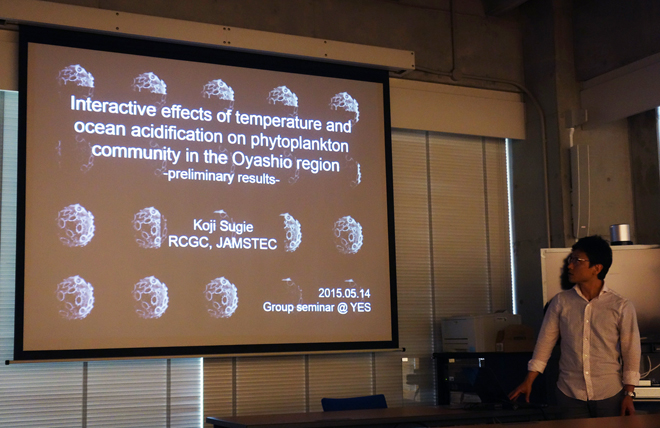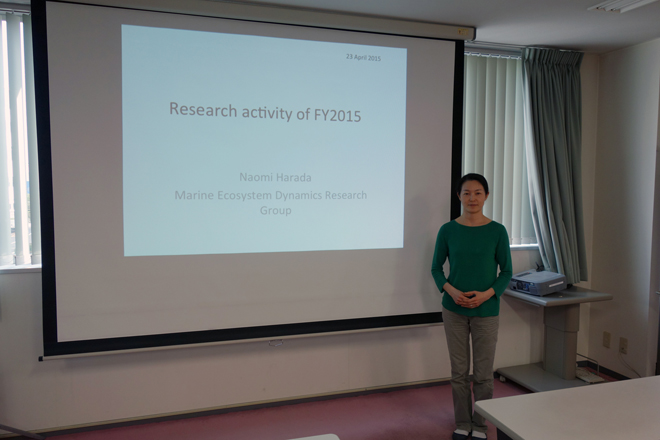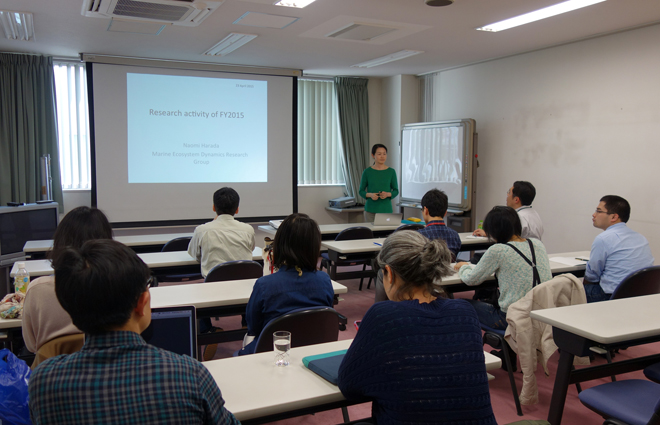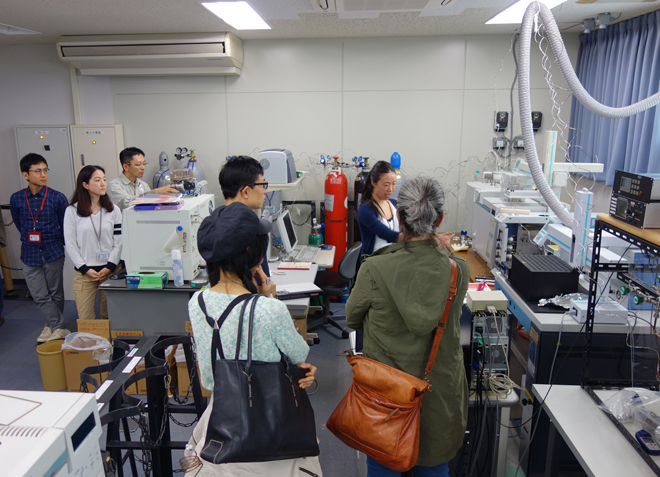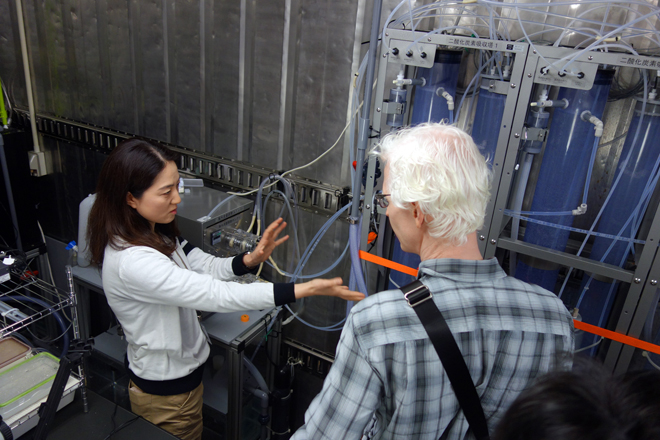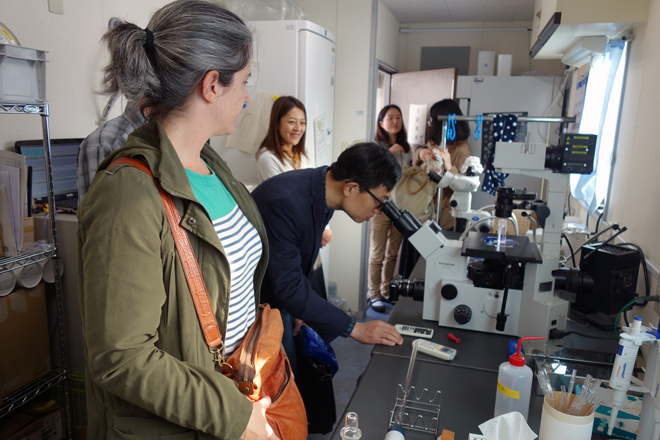We have the ecosystem group seminar at the first and third Thursday regularly for an exchange of information and views on research subject, and are publishing the abstract and part of slides used in the seminar on our website.
Schedule
* The schedule is subject to change if we have a guest speaker.
March 25, 2016
Yuriko Nakamura
"Method of density measurement using the MXCT"
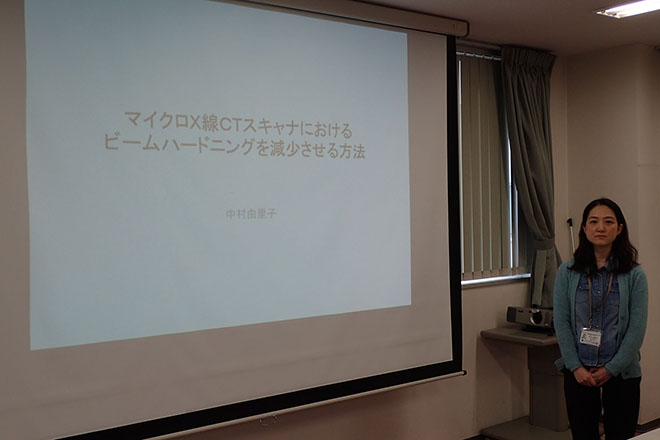
Maki Noguchi, Sanae Chiba, Kazuaki Tadokoro
"Decadal-scale variation of the lower trophic level marine ecosystem related to climate changes in the North Pacific"
Abstract
Interannual to interdecadal variations in the physical environment affect marine ecosystems by altering nutrient supply (both across the thermocline and via isopycnal advection). Today, We will give a brief description of the lower trophic ecosystem responses related to climate changes in dynamics, using data from 1948 to 2002 to drive a global three-dimensional physical-biological coupled model, '3D-NEMURO'. We will also present the decadal scale variation of the nutrients concentration in the Oyashio and Kuroshio-Oyashio transition waters from 1955 to 2010 and examined this influence on the marine ecosystems.
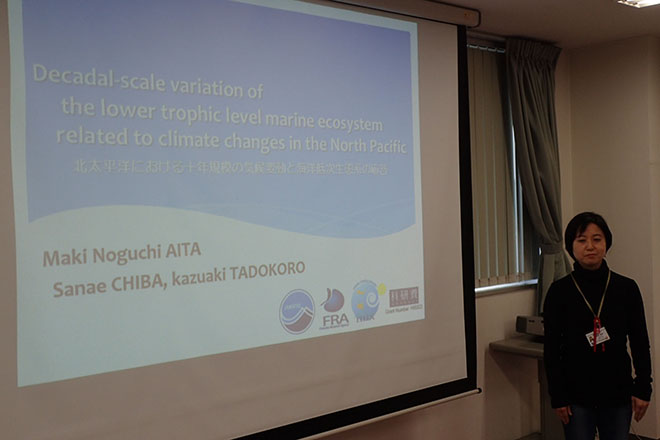
Feb 19, 2016
Toshimasa Doi
"Multidecadal change in the dissolved inorganic carbon in a long-term ocean state estimation"
Abstract
By using a four-dimensional variational data assimilation system capable of estimating physical and biogeochemical variables for the global ocean, we investigated multidecadal changes in the dissolved inorganic carbon (DIC) in the ocean. The system was newly constructed with a pelagic ecosystem model and an oceanic general circulation model to integrate available ocean observations obtained with a wide range of observation tools. The distribution of estimated DIC was by and large consistent with previous reports. We validated the changes in DIC along the World Ocean Circulation Experiment (WOCE) Hydrographic Program sections. The correlation coefficients of the modeled versus observed decadal difference patterns of DIC ranged from 0.25 to 0.51 in the Pacific Ocean, from 0.36 to 0.62 in the Atlantic Ocean, and from 0.23 to 0.57 in the Indian Ocean, and were significant at the 95% confidence level. Thus, at basin scale, the reproducibility of long-term climate change was similar. Estimation of vertical DIC fluxes in each basin showed that the fluxes changed on a multidecadal time scale in our system. These changes were possibly due to changes in the dynamical state of CO2 absorption and to changes in ocean circulation. Our integrated data set on the basis of a dynamically self-consistent ocean state is a promising tool for examining long-term changes in the ocean carbon cycle.
(in Japanese)
土居 知将
"海洋環境再現データセット(ESTOC)による溶存無機炭素の変動"
四次元変分データ同化システムを使って評価した全球の物理・生物地球化学変量のデータセットを用いて、海洋溶存無機炭素(DIC)の十年スケールの変動を調べた。このシステムは海洋大循環モデルと低次生態系モデルで構成されており、物理場に対しては四次元変分データ同化手法を、生態系モデルに対してはGreen 関数法を用いて、多様な観測ツールによって得られた海洋観測データを統合するものである。得られたDICの分布は過去の報告と概して一致したものだった。WOCE観測ラインに沿った鉛直断面上のDICの変化について、WOCEと再観測の差のパターンをモデルと観測で比較したところ、相関係数は太平洋で0.25~0.51、大西洋で0.36~0.62、インド洋で0.23~0.57であり、海盆スケールでの長期変動の再現性はどの海盆も同程度だった。各海盆で見積もったDICの鉛直フラックスは 10年スケールで変動している様子を示した。これらの変動は恐らく海面からの CO2吸収と海洋循環の変動によるものと思われる。ここで使用した海洋のデータセットは、観測値とモデルを統合して得た力学的に矛盾のないものであり、海洋炭素循環の長期変化の調査に有望なツールである。
Feb 4, 2016
Takuhei Shiozaki
"Reevaluation of new production in the ocean"
Abstract
Biological productivity is primary limited by nitrogen availability in the ocean. Therefore, depending on the nitrogen source, primary production is divided into new and regenerated production. New production is defined as production based on nitrogenous nutrient newly introduced from outside of the productive layer. New production is balanced with sinking particle flux in a steady-state system and thus is used to evaluate the capacity of the biological pump. In the open ocean, nitrate had been thought to be a major nitrogen source for new production, and its upward flux to the euphotic zone depends on stratification of the water column. However, nitrogen fixation is now recognized to contribute significantly to new production in the tropical and subtropical oligotrophic regions. Meanwhile, recent studies demonstrate that the generation of nitrate by nitrification near the surface is not negligible, indicating that nitrate assimilation method which is commonly used to estimate new production leads to overestimation. To improve our basic understanding of the biogeochemical cycle in the ocean, reevaluation of new production is requisite. In this presentation, I introduce my studies on nitrogen fixation and nitrification. Although I’ve studied new production mainly in the tropical and subtropical regions, my interest shifts to it in the Arctic region. I will talk about my next study in JAMSTEC.
Jun 21, 2016
Carmen Garcia-Comas Rubio
"Contrasting Relationships between Functional and Species Diversity in Subarctic and Subtropical Copepod Communities across the western North Pacific"
Abstract
Understanding how species coexist in rich communities and the role of biodiversity on ecosystem-functioning is a long-standing challenge in ecology. Comparing functional diversity to species diversity may shed light on these questions. Here, we analyze copepod species data from the ODATE collection: 3142 samples collected over a period of 40 years, which includes a 10° x 10° area of the Oyashio-Kuroshio Transition System, east of Japan (western North Pacific). The area hosts species characteristic of subarctic and subtropical communities. 163 copepod species were classified into five categorical functional traits (i.e., size, food, reproduction, thermal affinity and coastal-offshore habitat), following online databases and local taxonomic keys. We observe a general opposite hump-shaped relationship of species evenness (lower at mid-point) and functional diversity (Rao’s Q) (higher at mid-point) with species richness. Subtropical Kuroshio communities tend to be richer with higher species evenness, and yet subarctic and transition waters tend to host communities of higher functional diversity. The distribution of trait values within each functional trait was further examined in relation to the Species Abundances Distribution (SAD). In subtropical communities, the distribution of trait values in the species ranking is homogenous, mirroring the frequency of those trait values in the entire community. In contrast, in subarctic communities the distribution of trait values differs along the species rank, with dominant species having favorable trait values more often than expected by chance (i.e., based on the overall frequency of that trait value in the entire community). Our results suggest that subtropical communities may be niche-saturated towards the most adapted trait values, so that merely having the most adapted trait value confers no strong competitive advantage to a species.
S. Lan Smith (1), Kai Wirtz (2), Sandip Mandal (3), and Hidekatsu Yamazaki (4)
"Trait-based modeling of phytoplankton under realistic sub-scale variability"
(2) HZG (Helmholz Cntre for Materials and Coastal Research), Geesthacht, Germany
(3) Public Health Foundation of India
(4) Tokyo University of Marine Science and Technology
Abstract
Improved models have recently been developed of flexible physiology and adaptive changes in eco-physiological traits and trait diversity. Like nearly all theoretical descriptions and models of plankton dynamics, these trait-based models are still formulated at the macroscopic level, assuming uniform micro-scale distributions of organisms and their traits. However, recent observations have revealed that particles and plankton are in general distributed intermittently in aquatic environments, as aggregates at the μm- to cm-scale, which are often further organized into layers at the meter-scale and thinner. This micro-scale variability and structure of the aquatic environment, by controlling the availability of resources for plankton as well as their predator-prey interactions, must have shaped the trait distributions of plankton species. It must therefore also play roles in determining the response of plankton to changing environmental conditions. We apply a moment-closure representation of sub-scale variability to explore how sub-scale variability in the spatio-temporal distribution of plankton impacts the success of plankton having different trait values. Preliminary results with a simple phytoplankton functional type model show that sub-scale variability can impact model results at the macro-scale. We plan to extend this work to explore how sub-scale variability impacts the results of size-scaled models of phytoplankton communities.
Jan 8, 2016
Kazuyuki Miyazaki
"Toward a synergy use of multi-platform observing systems in constraining nitrogen and carbon cycles over East Asia and the Pacific"
Abstract
I will give an overview of my recent activities on the combined use of multi-platform observation data to constraint nitrogen and carbon cycles on the Earth’s surface especially over East Asia and the Pacific.
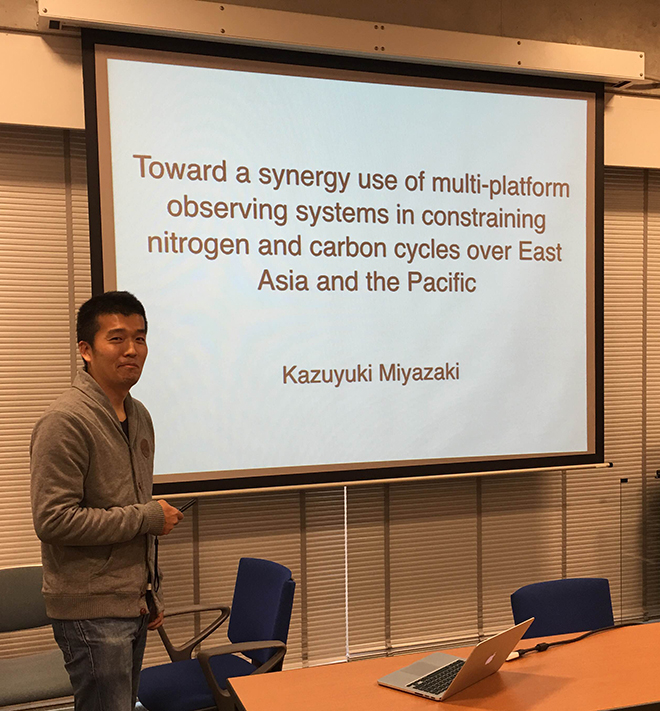
Kana Nagashima
"Asian dust transport change during the last century and its impact on ocean biogeochemistry"
Abstract
Asian dust has a significant impact on the natural environment. Its variability on multiple timescales modulates the ocean biogeochemistry and climate. We demonstrate that temporal changes in the depositional flux of aeolian dust recorded in sediments from Lake Suigetsu, central Japan, during the last century exhibit decadal-scale decrease during 1952–1974, which could be explained by weaker westerlies in lower latitudes including central Japan, reflecting weaker Aleutian Low during the corresponding period (ECMWF reanalysis data). Decadal-scale westerly change probably causes north–south shifts of the dominant dust transport path, which affect subarctic North Pacific biogeochemistry by changing the micronutrient iron supply. I will further discuss the possible link between the iron supply by Asian dust and primary productivity of subarctic North Pacific focused on recent years.
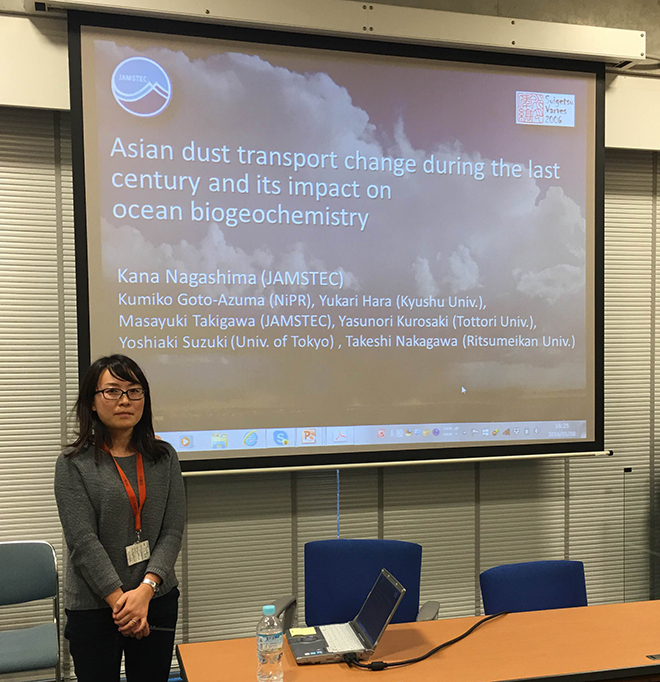
Dec 18, 2015
Koji Sugie
"Effects of temperature, low salinity and ocean acidification on the Arctic phytoplankton community during MR15-03 cruise – preliminary results –"
Abstract
I will show the preliminary results of a manipulation experiment conducted in the Arctic, where environmental conditions are changing. The increase in temperature and ocean acidity and the decrease in salinity are expected environmental stressors for marine biota in the future Arctic. However, impacts of these stressors on phytoplankton community in the Arctic are poorly studied. In September 2015, on-board incubation experiment (71°44’N 155°20’W) was conducted during MR15-03 cruise to test the effects of high temperature, low salinity, and high CO2 conditions on phytoplankton ecophysiology. The growth of phytoplankton community was enhanced by the increase in temperature and further enhanced by increasing pCO2 and decreasing salinity. Specific growth rate of small-sized phytoplankton was increased under the combination of high temperature, low salinity and/or high CO2. In the high temperature conditions, utilization of silicic acid relative to nitrate and phosphate decreased relative to the control temperature conditions, suggesting the contribution of diatom decreased because of the increase in temperature. High CO2 and low salinity conditions did not affect nutrient drawdown ratio of phytoplankton. According to these preliminary results, future warmer, less saline and high CO2 conditions in the Arctic may favor the dominance of small non-diatom phytoplankton which should have negative impacts on the efficiency of trophic transfer and biological pump.
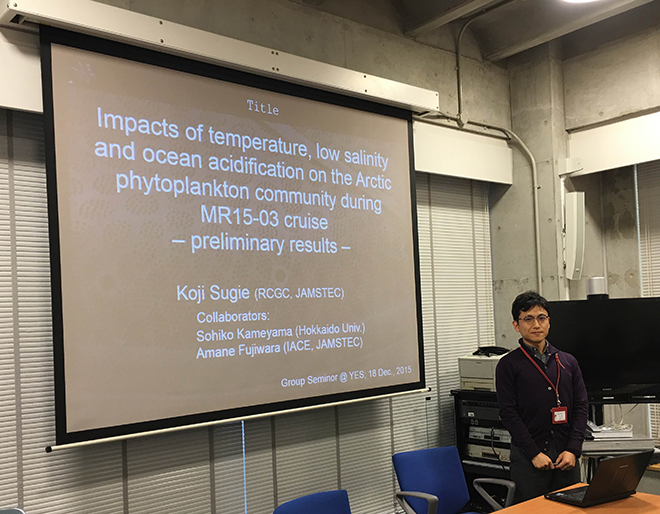
Jonaotaro Onodera
"The first annual deployment of pCO2 sensor in the western Arctic Ocean"
Abstract
In order to monitor hydrographic condition in the winter Pacific water layer (~170m depth), the optical pCO2 sensor (model 4797, Aanderaa Data Instruments) and other hydrographic sensors (CT, pH, DO, and ADCP) were moored at Station NAP13t in the southern Northwind Abyssal Plain (74°31.36N, 161°55.59’W) from September 2013 to September 2014. The obtained pCO2 data was calibrated using CTD data at fixed point observation in MR14-05 cruise. The calibrated pCO2 data ranged from 400 to 700 µAtom throughout the deployment period. Using CT, pH, and pCO2 data, time-series fluctuation of alkalinity and DIC was also estimated. In this presentation, I shortly show these data and some results of sediment trap experiment at NAP13t.
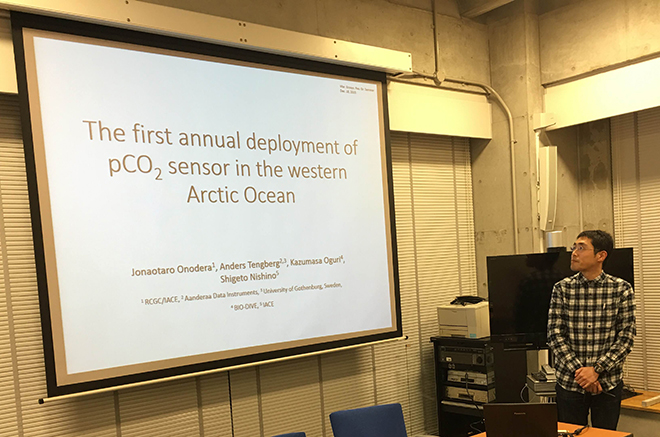
Dec 8, 2015
Dr. Ben A. Ward
"Disentangling the global plankton food-web: environment, resources and (mixo-) trophic controls"
Abstract
A wide range of plankton ecophysiological rates are fastest among the smallest cells. Tiny picophytoplankton are thus excellent competitors for nutrients, but are also highly susceptible to grazing by voracious nanozoooplankton. Larger size classes are not such good competitors for nutrients, but can escape this strong top-down control. This well-established paradigm does much to explain the observed size structure of marine plankton communities, but can be challenged on two counts: 1) not all physiological rates increase uniformly with decreasing size (maximum growth rate is clearly fastest for intermediate sizes), and 2) the majority of protist plankton groups in the 2-200 μm size range cannot be easily classified as either phytoplankton or zooplankton, as they benefit from both autotrophic and heterotrophic nutrition. I will discuss how these additional factors affect the ecological structure and biogeochemical function of marine plankton communities. Results from a global model of the plankton food-web reveal how a range of physical (light and temperature), chemical (nutrients), and ecological (trophic) factors determine distinct size-dependent niches in different environments. I will conclude with a discussion of the role of mixotrophy. Through their ability to combine both autotrophic and heterotrophic traits, the model mixotrophs are able to enhance the efficiency of resource exploitation, leading to increased trophic transfer efficiency, net community production and carbon export.
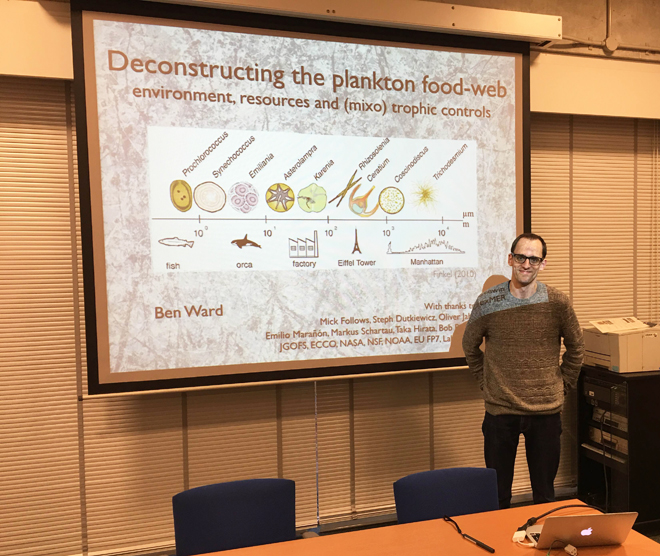
Nov 26, 2015
Yoshikazu Sasai
"Influence of oceanic mesoscale and submesoscale dynamics on biogeochemical reactions"
Abstract
Satellite ocean color image reveals the spatial variability in the surface chlorophyll distribution characterized by the several scales, which are gyre scale circulation, mesoscale eddies, and the submesoscale features. In the Kuroshio Extension, the energetic and time-varying pattern of chlorophyll is generated by the smaller-scale variability associated with the mesoscale eddies and submesoscale activity. In particular, the submesoscale variability associated with the oceanic turbulence is ubiquitous on instantaneous ocean color image, and has a few kilometers to tens of kilometers spatial-scale. We have investigated the influence of mesoscale and submesoscale dynamics on the biogeochemical fields using two realistic high-resolution models (1/10˚ and 1/30˚) coupled with a simplified ecosystem model. In comparison of biogeochemical distributions between 1/10˚ model and 1/30˚ model, the phytoplankton, zooplankton, and detritus concentrations in 1/30˚ model are larger than that in 1/10˚ model. The nitrate concentration in the subpolar region in 1/30˚ model is smaller than that in 1/10˚ model. The difference is greater in winter in the subtropical gyre and fall in the subpolar gyre. The 1/30˚ resolution model relative to 1/10˚ resolution model presents the energetic pattern of phytoplankton associated with the mesoscale and submesoscale features in early spring, but in fall, this submesoscale pattern is weak because the mesoscale variability is dominant. In winter, the energetic submesoscale variability plays a strong nitrate injection into the euphotic layer, and the distribution of phytoplankton is patchy with the finer-scale horizontal advection and the response time of growth. Influence of reproduced physical features in each model for the biogeochemical fields might be different.
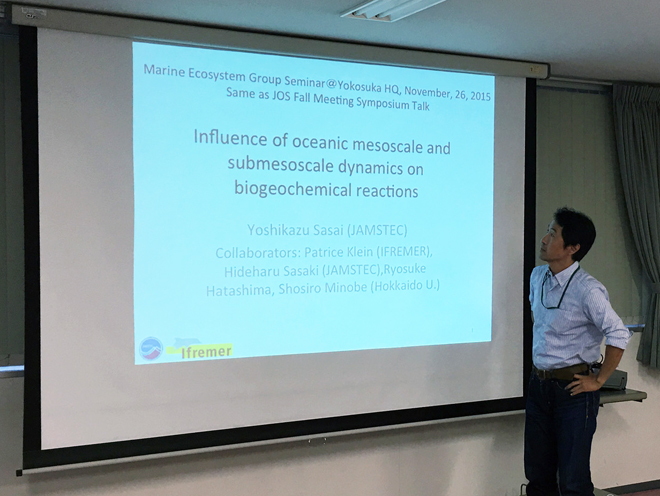
Naomi Harada
"Potential catastrophic reduction of sea ice in the western Arctic Ocean: its impact on biogeochemical cycles and marine ecosystems"
Abstract
The reduction of sea ice in the Arctic Ocean, which has progressed more rapidly than previously predicted, has the potential to cause multiple environmental stresses, including warming, acidification. Observational studies have been undertaken to detect the impacts on biogeochemical cycles and marine ecosystems of these environmental stresses in the Arctic Ocean. Observations and model simulations have both helped to clarify the impact of sea-ice reductions on the dynamics of ecosystem processes and biogeochemical cycles. In the presentation, I focus on the western Arctic Ocean, which has experienced the most rapid retreat of sea ice in the Arctic Ocean and report the impact of the current reduction of sea ice on marine biogeochemical cycles, including lower-trophic-level organisms, and identify the key mechanism of changes in the biogeochemical cycles, based on published observations and model simulations.
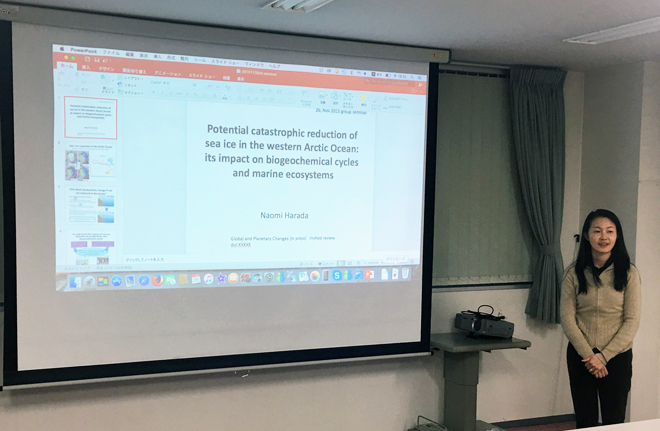
November 5, 2015
Dr. Pahlow Markus
"An optimality-based view on global biogeochemistry"
Abstract
I will present the application of our optimality-based phytoplankton model to satellite-based remote-sensing data. This work was part of the EU FP7 project Ocean Strategic Services beyond 2015 (OSS2015). Previous methods for estimating primary production have been based on empirical relations between remotely sensed signals and in situ observations, and unrelated to biological laws. Our new methods are founded on an optimality-based model which is based on inherently biological principles. We currently lack the ability to estimate effects of micro-nutrients (Fe) and atmospheric deposition, which are planned for the future. Nevertheless, our methods not only offer the potential for more reliable primary-production estimates but also provide insight into the physiological state of surface phytoplankton on a global scale. These include differentiation between light and nutrient limitation, prediction of C:N and Chl:C ratios in phytoplankton, and the contribution of phytoplankton to total particulate organic matter.
Dr. Bingzhang Chen
"Modeling phytoplankton size structure and diversity in the North Pacific: Preliminary reports from a size based adaptive model coupled with a 3D regional ocean model (ROMS)"
Abstract
Although relatively well known, the capacity of phytoplankton acclimation has not been widely applied in three-dimensional ocean circulation models. We are developing a size based plankton ecosystem model that is extended from a classic nutrient-phytoplankton-zooplankton-detritus (NPZD) model. The new ecosystem model incorporates the flexible behavior of phytoplankton physiology and is coupled with a 3D regional ocean model (ROMS). The key features of the new type of ecosystem model include: 1) A tradeoff exists phytoplankton photosynthesis and nitrogen uptake. Phytoplankton cells are assumed to optimize the energy allocation between light harvesting and nitrogen uptake. 2) We assume a continuous lognormal distribution of phytoplankton size. Key phytoplankton physiological parameters such as nutrient uptake rate, photosynthesis rate, minimal nutrient quota, etc. follow validated size-scaling laws. Then the net growth rate of the bulk phytoplankton community can be expressed as a function of the net growth rate at mean log size and the second derivative of net growth rate evaluated at the mean log size based on moment closure approximations. 3) A killing-the-winner strategy is adopted to maintain phytoplankton size diversity.
Until now, the model can faithfully reproduce the large-scale patterns of oceanic circulation, temperature, and salinity fields, while the simulation results for nitrate and phytoplankton biomass are less comparable with observation data, possibly due to the lack of iron in the ecosystem model. Sensitivity analysis suggests that the ecosystem model is very sensitive to the type of grazing functions and zooplankton mortality closure terms. Further efforts include: 1) tuning the model parameters for model outputs better matching the observation data; 2) adding the iron module; 3) optimizing the zooplankton module.
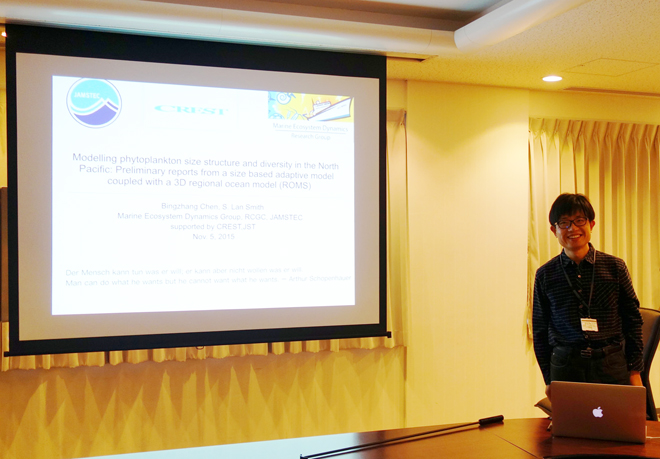
October 22, 2015
Haruka Takagi
"Stable carbon isotopic signature of foraminiferal photosymbiosis: Implementation of diffusion-reaction-uptake model"
Abstract
Stable carbon isotope (δ13C) in planktic foraminifers is useful proxy in paleoceanography and paleoecology. Especially, characteristic δ13C signature can be an indicator of paleo-photosymbiotic ecology in fossil foraminiferal species. The mechanism is grounded in the idea that the δ13C of the microenvironmental seawater surrounding a foraminifer is altered by vital activities such as photosynthesis and respiration, eventually recorded in foraminiferal tests. Recently, I conducted culture experiment of symbiotic foraminifers, feeding them to grow to form new chamber(s), and measuring symbiont photosynthesis by fast repetition rate fluorometry during the culture period. Subsequently, δ13C and δ18O of each secreted chambers were analyzed. To understand the effect of physiological activity on foraminiferal δ13C, I used a numerical model to simulate the isotopic composition in the microenvironment of each cultured foraminifer. In this presentation, I will show the preliminary results of the model and compare them to the measured chamber-by-chamber isotopic values of cultured foraminifers.
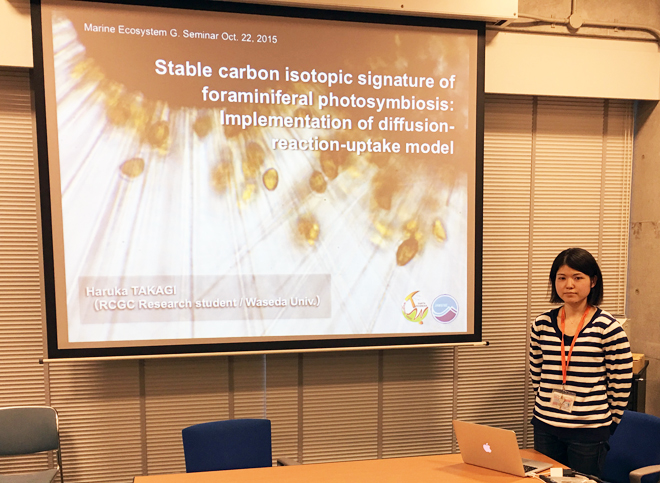
Fumihiro Itoh
"DNAseq based quantitative phytoplankton composition analysis from sediment trap samples"
Abstract
DNAseq based phytoplankton composition analysis is already established and reported. However, no one reported DNAseq based phytoplankton composition analysis from sediment trap sample. Because, most of the sediment trap samples are fixed by formaldehyde, which strongly inhibit the extraction and amplification of DNA. Therefore, we established new method of DNA extraction and purification from formaldehyde fixed sediment trap samples, and applied this method to NAP10t and NAP11t sediment trap samples. In the present talk will give a discussion about seasonal change of phytoplankton composition in NAP10t and NAP11t.
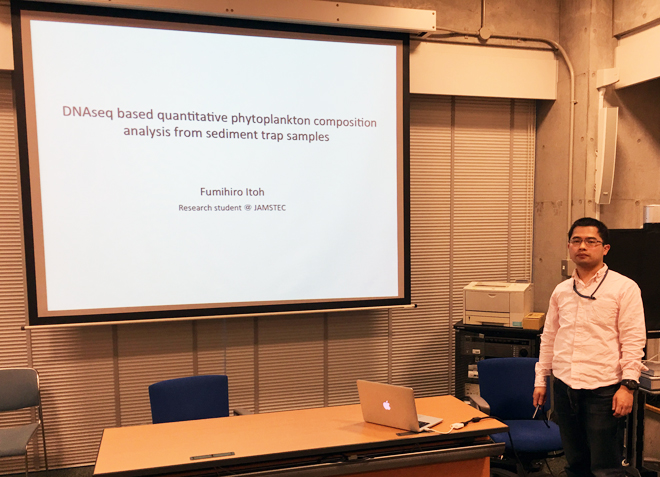
October 8, 2015
Eko Siswanto
"El Nino footprint on the South China Sea phytoplankton biomass at different time-lags"
Abstract
It is a well-known that El Nino decreases phytoplankton biomass (Chl) in the South China Sea (SCS) east of the Vietnamese coast due to weakened Ekman pumping. Recent study utilizing empirical orthogonal function analysis (EOF) however mentioned that decreasing biological productivity also occurs over the SCS basin with 4-month time lag. With simple regression analysis, this study showed that a remarkable decrease in Chl east of Vietnamese coast was already observed almost at no time-lag. Such a Chl decrease was likely caused by weakened winds.The decrease in Chl east of Vietnamese coast however expanded with increasing time-lags. The most remarkable decrease in Chl with the largest area over the center of the SCS was observed at 7-month time-lag (El Nino leading Chl by 7 months). By correlating zonal and meridional winds against El Nino index, this work suggested that the decrease in Chl over the SCS during El Nino was perhaps associated with anti-cyclonic anomalous wind circulation in the SCS.
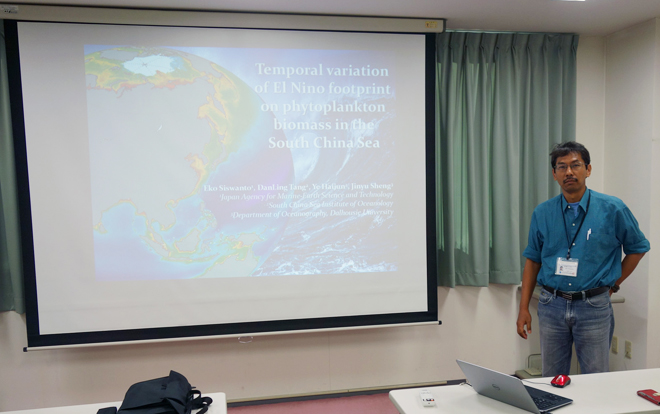
Minoru Kitamura
"Zooplankton dynamics revealed from 125-kHz acoustic data in the southern Chukchi Sea"
Abstract
To understand seasonal dynamics of zooplankton, mooring observation using 125-kHz echosounder was conducted in the southern Chukchi Sea from July 2012 to July 2014.
General patterns of Sa (area backscattering) seasonality were similar during the two-years long observation. That is, high Sa values were observed in autumn while low ones were recorded in early spring. Seasonal increasing of Sa was started in May, that was corresponded with increase of water temperature in the bottom layer. On the other hand, decrease timings of Sa during late autumn were different between 2012 and 2013, and environmental factor which affected the beginning of Sa decrease was still
unclear. Unexpectedly, increases of Sa in a small scale were observed in both winters. Diel vertical migration was recognized not only autumn but also winter.
These indicated that the dark and cold arctic winter is not a period without any biological activity.
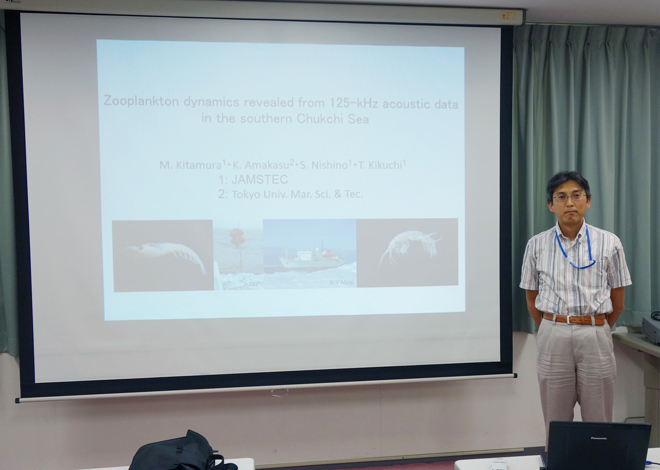
September 24, 2015
Katsunori Kimoto
"Outline for MXCT: scanning section of microfossils"
Abstract
MXCT (Microfocus X-ray CT) allows for high resolution 3D data and has been a useful method to assess, for example, the effects of ocean acidification on calcareous structures of foraminifera, corals, brachiopods and shelled pteropods. To visualize the structure of such biological materials, MXCT use X-rays to generate a series of digital, sequential two-dimensional cross-sectional slices. The biological material is detected by differences in X-ray attenuation as the X-rays pass through it. Depending on the density of the material, the X-rays will be absorbed or scattered. The X-rays finally reach a detector where their intensities are recorded as a voxel value (16 bit, 65,536 grayscale contrasts). As a result, a highly dense material will appear more opaque than a less dense material. After assembling these two-dimensional images using computer software, a three-dimensional model can be reconstructed. This 3D-model can be used for measurements and visualization of features.
In this May, we installed a new instrument of MXCT (Comscantechno co, ltd, Shinyokohama, Japan). Since then, we had trained for using to achieve best images of any biological materials. In this seminar, I will introduce some recent activities and concerning issues to establish shell density analysis of carbonate shells.
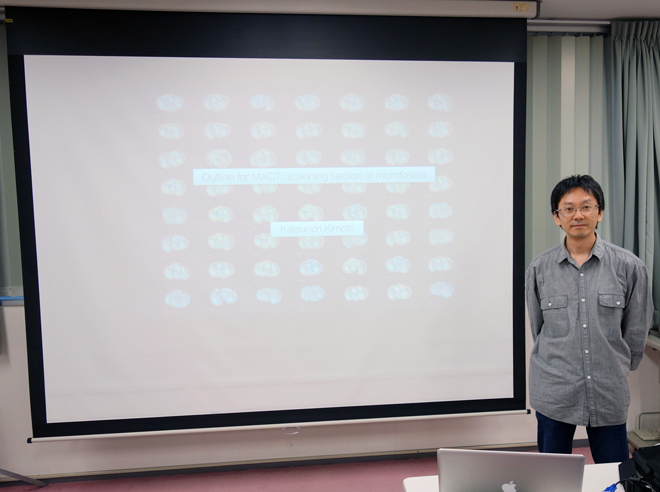
Maki Noguchi Aita
"Title: Nitrogen and Carbon isotope ratios of the lower trophic level food web system ~preliminary results at A-line, KH-15-1 cruise"
Abstract
Carbon and nitrogen isotope ratios of biota are controlled by two factors, a metabolic system and a lifestyle of predator and a regional variability of environmental parameters on food-web system. To evaluate the environmental factors on the basic food-web in the marine ecosystem, we inspected how Δδ15N / Δδ13C of the zooplankton changed by the difference in the water mass. We carried the observations in three water mass: Coast Oyashio water (COY), Oyashio water(OY) and Warm-Core Ring(OUT) along the A-line monitoring transect (38N-42.5N, 144.5-147.5E) in March 6 - 26, 2015 cruise KH-15-1 of the R/V Hakuho-maru. Zooplankton samples were collected from 150 m depth to the surface using vertical tow of a NORPAC twin net (45cm mouth diameter, 0.355 mm mesh size). We also collected water samples from vertical profiles in δ15N (NO3+ + NO2-) together with zooplankton δ15N in special reference to nitrogen cycles. Analysis of the sample is currently in progress; I will present a brief introduction of the KH15-1 cruise.
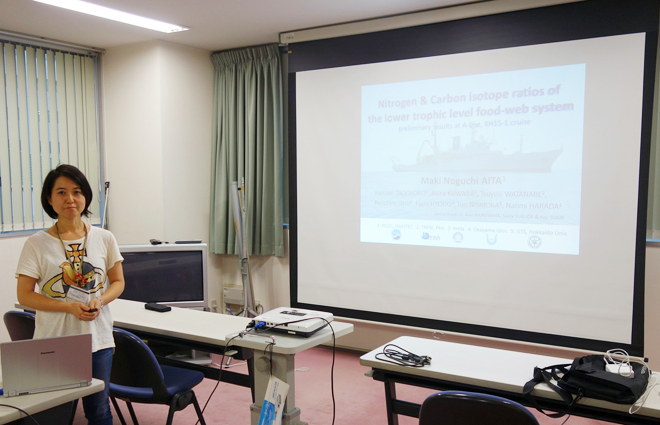
September 10, 2015
Tetsuichi Fujiki
"Overview of the R/V Hakuho-Maru (KH-15-J01) cruise"
Abstract
To better understand the response of marine ecosystem to the ocean acidification, we carried out the research cruise in the subarctic western North Pacific from 29 June to 13 July 2015. At time-series station K2 during the cruise, we conducted the following observations and operations: (1) the recovery/deployment of buoy systems, (2) CTD cast and water sampling/biochemical analysis, (3) plankton sampling by using the VMPS, ORI and NORPAC nets, (4) particle collection by using in situ filtration system, (5) performance evaluation test of the Hybrid CO2-pH sensor. Here, I present an overview of the R/V Hakuho-Maru (KH-15-J01) cruise.
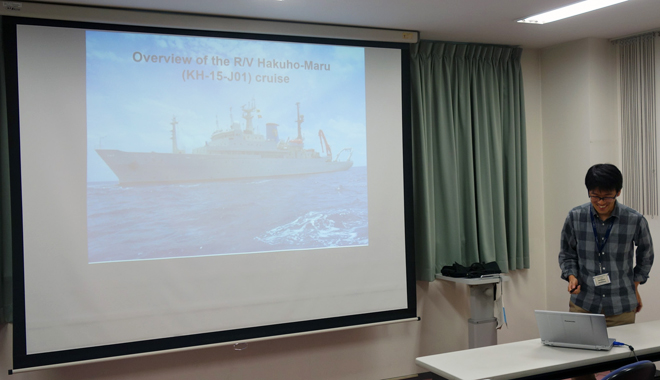
Miyako Sato
"First half of 2015 fiscal year work report"
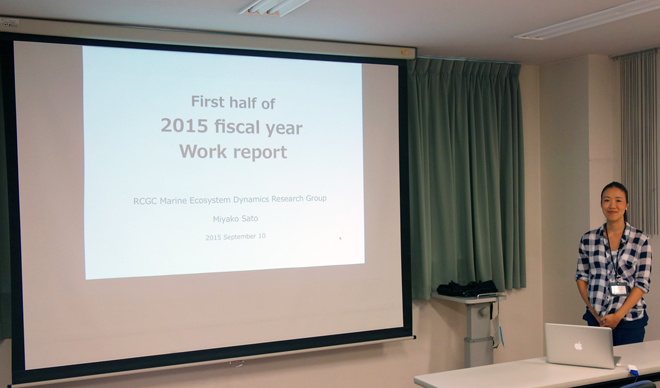
August 28, 2015
Hidekatsu Yamazaki (Tokyo University of Marine Science and Technology)
"Observation of fluorescent microstructures and development of closure models"
Abstract
Micro-scale aquatic ecosystems are the engine for earth's biogeochemical cycles. Phytoplankton fix inorganic carbon to organic carbon through the photosynthetic process. Although phytoplankton are single-celled organisms, they often appear in an aggregated form that elevates local fluorescence signal intensity. To explore this phenomenon, we have developed a new free-fall microstructure profiler. It carries a new laser fluorescence probe that resolves millimeter scale fluorescence fields, as well as a DSL CMOS camera system that records a 1024x1280 pixel image with a pixel resolution of 330 μm.
Millimeter scale fluorescence signals obtained from the laser probe are considerably more intermittent than the cm-scale signals. We show that fluorescence signals at the millimeter scale exhibit high values of the coefficient of variation and that the signals are no longer a Gaussian process. We found a transition scale that separates a continuous Gaussian process to a discrete event series. We also found that a mean marine aggregate size measured by the DSL camera, for the first time, shows a positive correlation with the kinetic energy dissipation rate up to the Kolmogorov scale.
Based on these observed facts, we have developed a new plankton dynamics model making use of closure approach, which is commonly used in turbulence study. Fist of all, we developed a NP closure model and the dynamics is compared against the conventional NP model. We found a critical parameter that separates the dynamics of the NP closure model from the conventional model. We implemented this model into one-dimensional mixed layer model. We also blended the new trait idea of Smith et al. (2015) to develop an adaptive NP closure model. The results from these developments are presented at the seminar.
Anupam Priyadarshi (Tokyo University of Marine Science and Technology)
"Intermittent plankton data and NPZ closure model"
Abstract
The conventional plankton models are developed on the basis of mean-field theory in which only mean of planktonic variables are considered. Dobell et. al. (2009) reported that high variance is ubiquitously present in micro-scale phytoplankton data and plays a vital role in determining the plankton dynamics at millimeter scale. Mandal et. al. (2014) established a new methodology for NP model referred to closure approach that is widely used in turbulence theory but so far only rarely in ecology. They found that NP closure model has different dynamics than the conventional NP model beyond a threshold parameter value.
We developed NPZ closure model assuming mean and fluctuating component of plankton variables. The results are compared with conventional NPZ model as well as NP closure model. The standardized total variability in NPZ closure model enhances the higher trophic level and increases the parameter domain of coexistence of all planktonic
variables. The coefficient of variation of phytoplankton is found to be always greater than one in case of stable solutions in NPZ closure model. Further, standardized total variability β may enhance the biodiversity (since variability broadens the coexistence region) and in particular, stability in the natural ecosystems.
The results of NPZ closure model will be discussed in detail in the seminar.
Debaldev Jana (Visva Bharati University)
"Impact of physical and behavioral prey refuge on prey predator interactions in Sundarban mangrove eco-systems: a mathematical study with ecological ramification"
Abstract
After the pioneering studies of Lotka and Volterra, predator-prey interactions were studied extensively and will continue to be one of the dominant themes in ecology due to its universal existence and importance. A large body of theoretical works investigate the interaction between prey and predator in a habitat where no complexity is present, here the term “habitat complexity” signifies broadly and elastically, i.e., physical and as well as behavioural structure of habitat. But in nature there are no habitat which is truly free of complexity either aquatic or terrestrial habitat, for example, aquatic habitat becomes complex by submerged vegetation, aquatic weeds, salinity, flow of fresh water etc.
Every population should exploit a specially variable and diverse environment so as to increase their Darwinian fitness. Dynamics of any local population depends upon attributes of the local habitat.
Predator's functional response, defined as the amount of prey catch per predator per unit of time, is affected by the structure of habitat, prey’s strategy to overcome foraging efficiency of predator etc. So, physical and behavioural prey refuge concepts come forward to observe and analyse the system. Effect of the degree or strength of prey refuge in discrete and continuous system is observed. Also sometimes
degree of refuge significantly affects the birth process of prey population, so interplay between prey refuge and Allee threshold is also investigated. These types of vast dynamical aspects play a significant role on the dynamics of specialist as well as generalist types of predator. Also, negative and positive feedback delays highly characterize the system.
Aug 25, 2015
Agostino Merico
(Leibniz Center for Tropical Marine Ecology, Bremen, Germany)
"Sustaining diversity in trait-based models of phytoplankton communities"
Abstract
Trait-based models of phytoplankton communities appear to be ideal tools for describing the evolution of large assemblages of species with aggregate properties of group characteristics such as total biomass, mean trait, and trait variance, the latter representing the functional diversity of the community. Such an approach, however, is limited by the tendency of the trait variance to unrealistically decline to zero over time. This tendency to “loose” diversity, and therefore adaptive capacity, is typically solved by assuming a constant variance or by considering exogenous processes such as immigration. Exogenous processes, however, cannot explain the maintenance of the adaptive capacity often observed in the closed environment of chemostat experiments. Here we present a new method to sustain diversity in adaptive trait-based models of phytoplankton communities based on a mechanism of trait diffusion through subsequent generations of species. The method accounts for the maintenance of biodiversity via processes such as rapid evolution or transgenerational trait plasticity.
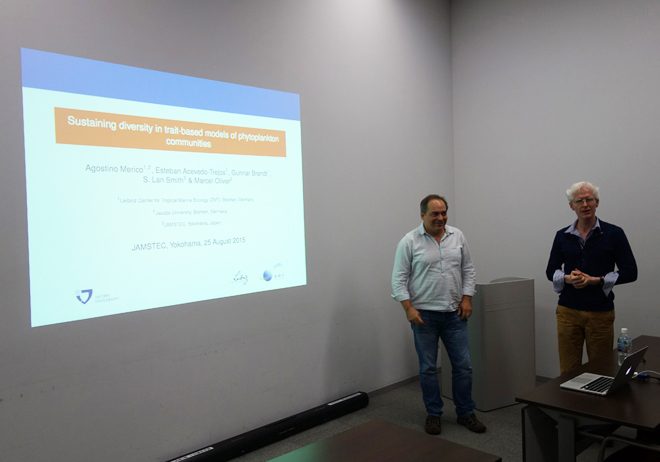
Sergio M. Vallina
(Institute of Marine Sciences (ICM), Spanish National Research Council (CSIC))
"Phytoplankton functional diversity, productivity and stability"
Abstract
The effect of biodiversity on ecosystem functioning is one the major questions of ecology. However, the role of phytoplankton functional diversity in ecosystem productivity and stability under fluctuating (i.e. non-equilibrium) environments remains largely unknown. Here we use a marine ecosystem model to study the effect of phytoplankton functional diversity on both ecosystem productivity and its stability for seasonally variable nutrient supply and temperature. Functional diversity ranges from low to high along these two environmental axes independently. Changes in diversity are obtained by varying the range of uptake strategies and thermal tolerances of the species present in the community. Species can range from resource gleaners to opportunists, and from cold to warm thermal tolerances. The phytoplankton communities self-assemble as a result of species selection by resource competition (nutrients) and environmental filtering (temperature). Both processes lead to species asynchrony but their effect on productivity and stability differ. While the diversity of thermal niches has a strong and direct positive effect on productivity and stability, the diversity of uptake strategies has a weaker and indirect positive effect. Thus, the effect of biodiversity on ecosystem functioning depends on the type of environmental gradient. Yet, our results show that more diverse communities do lead to higher and more stable ecosystem productivity than less diverse communities. These results provide new insights into the insurance hypothesis of biodiversity for marine microbial communities.
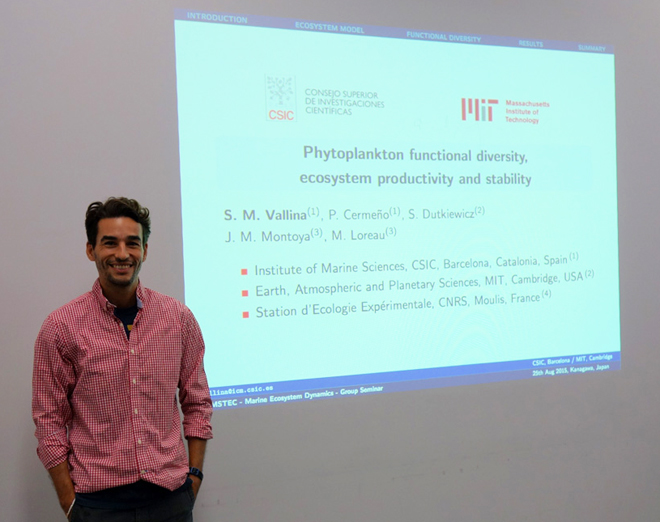
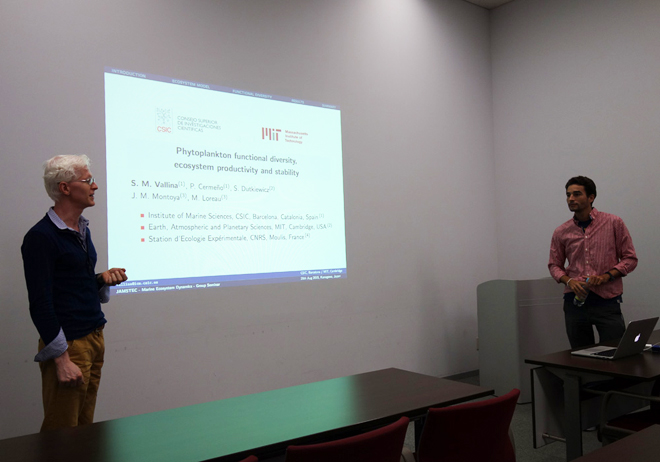
Aug 6, 2015
Sanae Chiba and NEOPS Long-term change research team
"Toward the effective global ecological and biogeochemical observation planning - recommendation from the study on new ocean provinces, NEOPS project"
Abstract
With an increasing demand for better understanding of climate change impacts on the marine ecosystem and biogeochemical cycle, the international ocean science community has been seeking the best way to establish the global ecological and biogeochemical observation systems. Different from physical oceanography which parameters are globally measurable by already established methods, the bottleneck is how we could measure the complex ecological and biogeochemical parameters in basin to global scales in cost-effective ways. Our paper is to present an idea for designing the effective global ecological and biogeochemical observation plans based on the ocean provinces, which were newly developed through the NEOPS (New Ocean Paradigm for its biogeochemistry, ecosystem, and Sustainable use) project (http://ocean.fs.a.u-tokyo.ac.jp/index-e.html) funded by the Japan Society of Promotion of Science. We analyzed seasonality of biogeochemical properties (nutrients and pCO2) and phytoplankton abundance using VOS (Voluntary Observing Ship) data and satellite ocean color data, respectively, which have been collected over 10 years since 2000. Then we divided the North Pacific into c.a. 10~15 ocean provinces based on the similarity in seasonal variations of the respective properties. Since we defined the provinces with the “dynamic” rather than “static” boundaries, locations of the boundaries between the provinces interannually varied both in the biogeochemical and phytoplankton province maps. Interannual shifts of the boundaries were detected in a larger extent in some regions, e.g. along the Kuroshio Extension and around the Gulf of Alaska, indicating that phonological changes in biogeochemical and ecological processes are particularly susceptible to climatic control in those regions. We also found high interannual variation in zooplankton community structure in the same regions. We expect the NEOPS new ocean provinces might be useful to propose the focal regions that should be intensively observed with relatively high temporal and spatial resolutions.
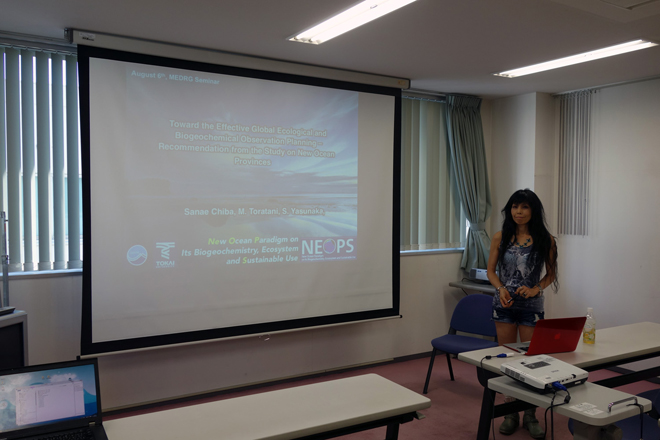
Taketo Hashioka and NEOPS Long-term change research team
"Ecological provinces in the global ocean based on biogeochemistry"
Abstract
As one of activities of NEOPS project, we propose a new ecological provinces based on biogeochemistry. Classically biological provinces have been defined by a similarity based classification of seasonal variation of chl-a concentration typified by Longhurst 1995 and 2006. Such a categorization well captured the regional differences of lower-trophic level ecosystem. However, it was difficult to understand regional differences of background mechanisms. Recently several new biogeochemical data are available. One is an estimation of phytoplankton community structure from satellite observation. Another is physiological state of phytoplankton simulated by ecosystem models. In this study, we defined a new ecological provinces as a combination between dominance of phytoplankton and their physiological statement. Herewith, even if regions are defined as different biological provinces from the geographical information, it becomes clear that the background mechanism is the same between regions. The converse relationship also becomes clear. In the presentation, we will present a preliminary results for future projection of ecological provinces through analysis of results from model intercomparison projects (CMIP5 and MAREMIP).
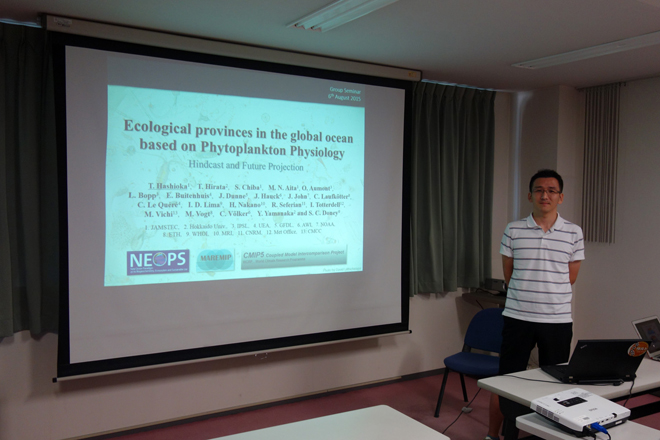
July 23, 2015
S. Lan Smith
"Progress so far and plans for the second half of our CREST research project"
Abstract
Our CREST project, entitled “Developing a new marine ecosystem model to represent the adaptive capacity of plankton in the North Pacific”, is now in its third year (of 5.5 total), and therefore its mid-term evaluation will be conducted during the next few months. I will briefly summarize our progress so far and present the plans and expected outcomes for the remainder of this project. We have developed new prototype models of the flexible response of phytoplankton and zooplankton communities, and we are beginning to apply these in coupled physical-biological (three dimensional) models of the North Pacific. We have also compiled a database of observations, including time-series observations from JAMSTEC stns. K2 and S1 in the North Pacific, Stable Isotope (SI) measurements of zooplankton, size-spectra for meso-zooplankton, and long-term, large scale zooplankton observations from Continuous Plankton Recorders (CPRs). For the remainder of the project, I plan to combine the models developed so far into a new model of Trophic Level Variability (TLV), as quantified by the δ15N stable isotope ratio of different plankton groups, and use this new model together with the observations to test the effects of eco-physiological processes on trophic transfer. The ultimate goal is to better understand the processes that control the transfer of energy and matter up the food chain to support higher trophic levels, which include fisheries, and thereby to enhance the usefulness of observations as indexes of the ability of lower-trophic (plankton) ecosystems to support higher trophic levels.
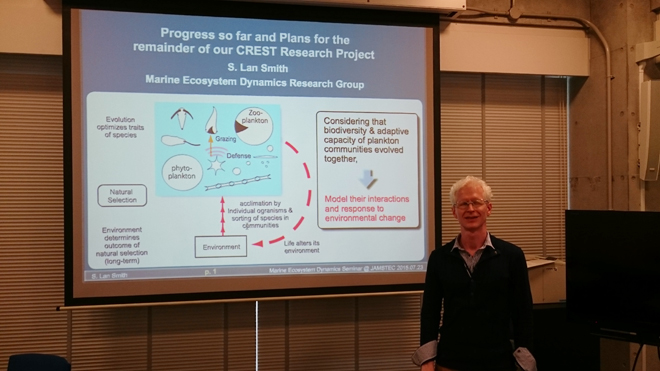
Paulina A. Prondzinsky (visiting as an intern from Jacobs University, Bremen, Germany)
"Introduction to my research experience and interests"
Abstract
As an intern at JAMSTEC, I would like to use this seminar as an opportunity to introduce my educational background and research interests to the wider community. Studying Earth and Space Sciences in Bremen, Germany, I came to JAMSTEC for my internship to work in a research institution focusing on the marine sciences, since this is the working environment I am interested in for my future career. Over the course of the last two years I already got some insights to research and field work on various excursions related to geology, marine biology and plankton ecology. I am mainly interested in marine microbiology and will most likely continue my studies in a graduate program after graduating in Bremen next year. I will present some of the research conducted in Bremen and on the excursions, as well as a summary of the work that I have been doing here up to now.
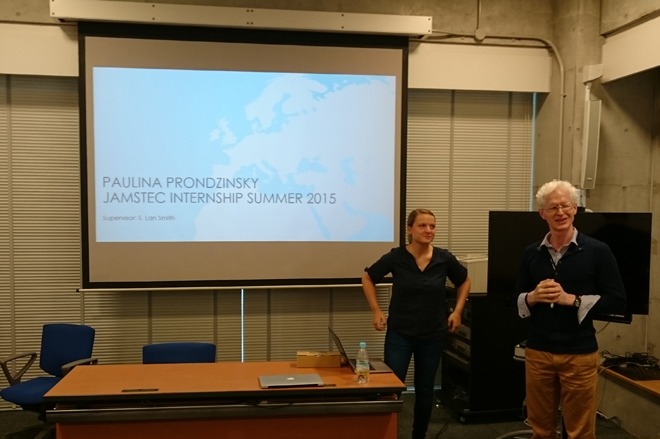
June 25, 2015
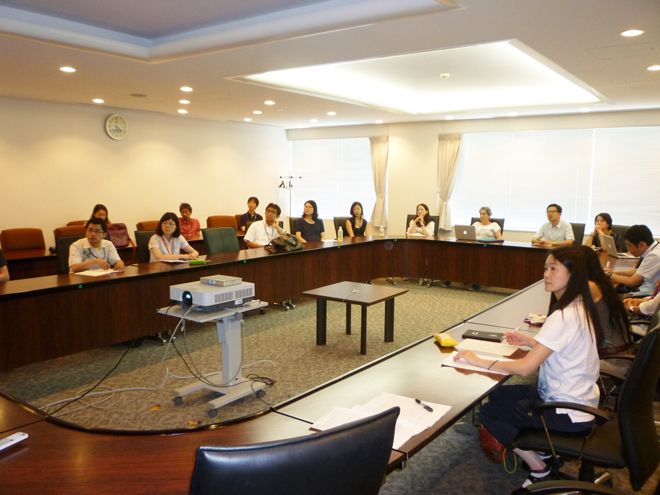
Kana Nagashima
"Decadal-scale linkage between the Aleutian Low intensity and Asian dust transport during the last 100 years"
Abstract
The knowledge of variations for the Asian dust transport is critical to examine the interactions between the Asian dust and atmospheric environment, climate, and ocean biogeochemistry. Here we demonstrate that temporal changes in the depositional flux of eolian dust in sediments from Lake Suigetsu, central Japan, during the last ca. 100 years exhibit variations mostly in harmony with North Pacific Index, with the increases during 1920–1950 and 1977–2004 when the North Pacific Index was negative reflecting stronger Aleutian Low. Similar Asian dust increases are also reported from optically defined dusty days in Korea. These periods are also characterized by the large southward meandering of the westerly jet over East Asia, suggesting the decadal-scale changes of the westerly jet path following the intensified Aleutian Low efficiently transport Asian dust to the Korea, Japan, and probably to the subtropical North Pacific, but decrease the dust transport to the subarctic North Pacific.
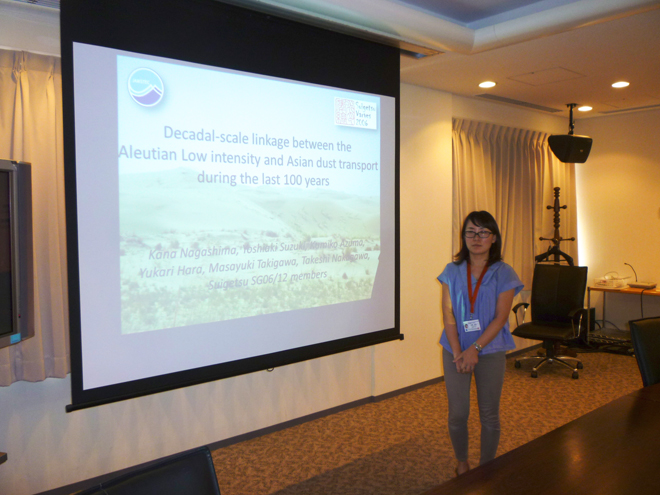
Carmen Garcia-Comas Rubio
"Comparison of copepod species-based and individual-size-based community structuring"
Abstract
Functional trait studies are proliferating in plankton ecology. In particular those analysing body size for its influence on various biological and predator-prey rates. Despite species and size composition representing the most well studied community descriptors in plankton ecology, robust empirical studies comparing both are very rare. Existing studies usually lack fully resolved data; that is, individuals are not identified to species level, and/or size corresponds to species average size instead of individual size. Here, we compared copepod species-based and individual-size-based community structuring, tested intrinsic factors potentially affecting their relationship (i.e., species richness, and proxies for: size partitioning of species without accounting for intraspecific variability, intraspecific variability without accounting for ontogeny, and ontogeny) and investigated how they respond differently to environment. We found that species and size structuring significantly matched; nevertheless, they provide complementary information in revealing how copepod community responded to environment. Importantly, we found that juveniles in the community critically affect individual size distribution, and the frequency of juveniles is the only intrinsic factor significantly explaining the mismatch between species versus size structuring. Our results stress the importance of considering population dynamics in community structure and functioning, and support individual-size as a complementary tool to explore zooplankton community dynamics.
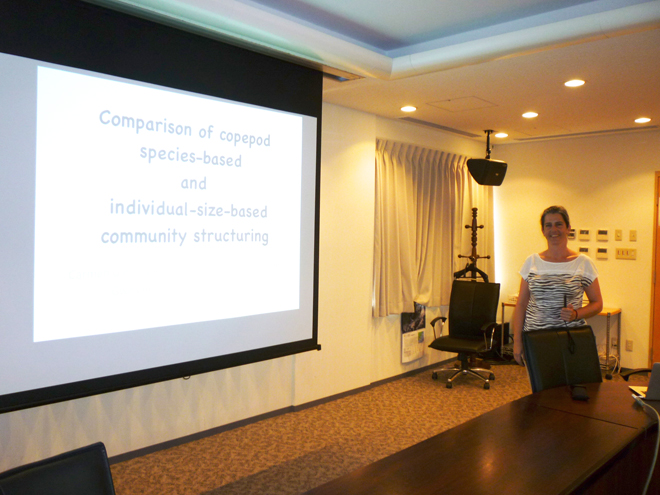
June 11, 2015
Tomoko Yoshiki
"Hydrostatic pressure effect on copepod recruitment"
Abstract
In our previous result showed that northerly shift of warm-water copepod distribution has been observed with SST increment in western North Pacific, while that cold-water copepod species such as Neocalanus species did not show obvious changes in their distribution with SST variations. In the present talk will give a discussion about the differences between responses of warm-water species and cold-water species, considering the egg response to temperature and hydrostatic pressure change.
Jonaotaro Onodera
"Preliminary results on the settling particle fluxes at Station NAP in the western Arctic Ocean from 2010 to 2014"
Abstract
Bottom-tethered sediment trap mooring had been deployed at Station NAP in the southern Northwind Abyssal Plain from October 2010 to September 2014. The settling particle fluxes of total mass and organic matters were analyzed throughout the monitoring period. Seasonal maxima of particle fluxes were usually observed in every early winter and summer except for 2012. The low particle fluxes in 2012 are probably explained by temporal westward expansion of oceanic and oligotrophic Beaufort Gyre water. I will also show the deployment plan of sediment trap moorings from this year to 2018.
Apr 23, 2015
Kazuyuki Miyazaki
"Satellite measurements of atmospheric constituents for studies of global carbon and nitrogen cycles"
Abstract
This talk will give a brief overview of past, present, and future satellite measurements of atmospheric constituents that can be used for studies of global carbon and nitrogen cycles.
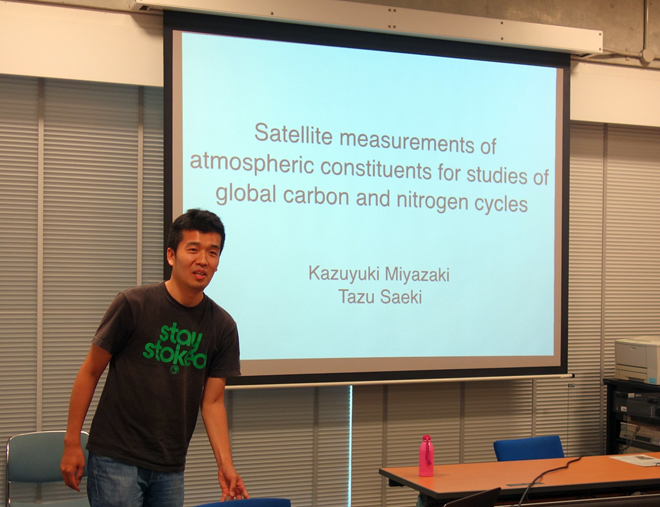
Koji Sugie
"Interactive effects of temperature and ocean acidification on phytoplankton community in the Oyashio region – preliminary results –"
Abstract
On-board incubation experiment was conducted at 41.53°N 145.50°E in March 2015 to test the interactive impacts of ocean acidification and warming on biogeochemical cycling of bio-elements and diversity of phytoplankton. In this presentation, I will show the culture design and some preliminary results. In brief, high temperature significantly increased the growth rate of all phytoplankton, whereas high CO2 suppressed the growth of large-sized (>10 μm) phytoplankton. The Fe addition slightly enhanced the growth rate of phytoplankton after the 7 days of incubations, suggesting the carrying capacity of spring bloom in this region will be limited by iron availability. High temperature may alleviate the negative effect of high CO2 on the net growth rate of phytoplankton.
